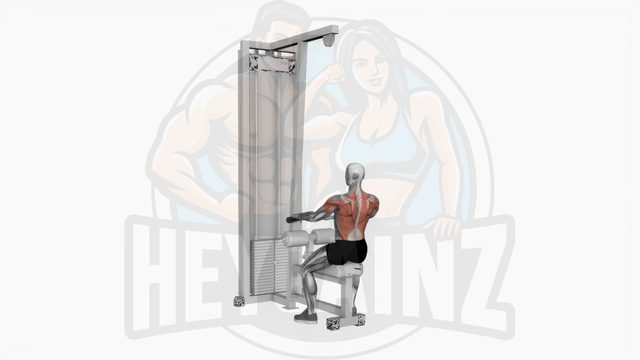
Instructions:
- 1Sit on a bench with your back straight, knees bent, and feet on the floor.
- 2Extend your arms to hold the machine's handle with an overhand grip by placing your hands shoulder-width apart.
- 3Pull the bar towards your chest while folding your arms and taking your elbows past your back.
Tips:
- Keep your back nicely arched and avoid slouching.
- DonÆt keep your elbows very close to your torso.
- Maintain a smooth breathing pattern and avoid breath-holding.
Cable Low Seated Row: Strengthen Your Back and Improve Posture
The cable low seated row is a fantastic exercise designed to engage multiple muscle groups in your upper body, primarily targeting the muscles of the back, including the latissimus dorsi, rhomboids, and trapezius. This exercise is performed using a cable machine and is often recommended for individuals looking to enhance their rowing technique, build strength, and improve posture.
When performing the seated cable low row, the primary muscles worked include:
- Latissimus Dorsi: These large back muscles help in pulling movements.
- Rhomboids: Located between the shoulder blades, these muscles are crucial for retracting the scapula.
- Trapezius: This muscle aids in the stabilization and movement of the shoulders and upper back.
For those exploring variations, consider the underhand seated cable low row to target your lower back in a slightly modified way, or try the extended seated cable low row for a broader range of motion. If you're looking for alternatives, the seated single arm cable low row can also help focus on each side of your back independently.
Many individuals wonder about the difference between a low cable row vs seated row. While both exercises aim to strengthen your back, the cable low seated row emphasizes pulling from a lower position, which can engage the muscles slightly differently and may provide greater tension throughout the range of motion.
Here are some tips to enhance your cable low seated row experience:
- Posture: Keep your back straight and avoid rounding your shoulders to minimize the risk of injury.
- Grip: Experiment with different handles such as seated low cable rows D handles to find variations that feel comfortable and effective.
- Breathing: Inhale during the recovery phase and exhale when pulling the handle towards you.
- Control: Focus on slow and controlled movements to maximize muscle engagement.
Incorporating the cable low seated row into your workout routine can lead to significant improvements in strength, stability, and overall upper body functionality. Whether you're a beginner or an experienced lifter, this exercise can be tailored to suit your fitness level and goals.